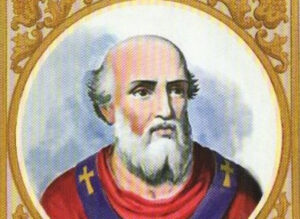Many saints of the Church have received the crown of martyrdom because of the policies of political leaders – from the first Christian martyrs who refused to reverence state deities or to acknowledge emperors as divine to those who suffered in the twentieth century at the hands of atheist Communist leaders. In the intervening centuries, there were many other situations in which a Christian could suffer for his faith, even at the hands of those who also called themselves “Christian.” The Roman Pope St. John I fell asleep in the Lord on May 18, 526, due to the harsh conditions which he suffered when he was imprisoned by the Ostrogothic King Theodoric.
Two hundred years after Arius first propounded his idea that God the Son was not equal to God the Father, the Arian heresy was still active among the converted tribes which had settled in Europe as the Roman Empire dissolved in the West. Among those tribes, the Ostrogoths had come to rule in parts of Italy in the 6th century. King Theodoric, whose headquarters were at Ravenna, was an Arian, but his position was becoming tenuous. As early as 506, the Frankish King Clovis had converted to Orthodox Christianity and in 510 Theodoric’s own son-in-law, Sigismund of Burgundy, became Orthodox. When Theodoric’s brother-in-law and compatriot in the Arian religious view, the Vandal King Thrasimund, died in 523, Theodoric felt threatened. If rulers and their people in the West were of the same faith as those in the East, the Emperor had greater possibility for reuniting the Christian world and diluting the power of the smaller rulers such as himself.
Lashing out at this threat, Theodoric accused the eminent Christian philosopher Boethius of conspiring with the Emperor against Gothic rule and had him executed. Emperor Justin reacted to this by enacting a law banning Arian churches in the Byzantine territories, making Theodoric even more defensive. Pope John was caught in the middle of these power plays.
John had been one of the seven deacons of Rome when he was elected to the papacy following the death of Pope Hormisdas. John was already fairly old and frail when became pope, and he was definitely not happy to be sent on a difficult mission for the Arian ruler. But Theodoric ordered the bishop to travel to Constantinople to demand that the new edict be rescinded, that earlier regulations which had allowed Orthodox Christians to take over the buildings of Arians be reversed, and that people who had converted from Arianism to Orthodoxy be allowed to return to their earlier Arian beliefs. Pope John protested against this mission, but the king threatened harm to the Orthodox in Italy if their bishop did not carry out his orders.
Traveling with several other bishops and some senators, Pope John left on his arduous journey and was heartened by the reception he received upon his arrival shortly before Pascha of 526. People went out of the city to greet the bishop as he arrived and Emperor Justin was very cordial to him. The pope was even given the privilege of celebrating the Western Liturgy in Latin in the great church of Hagia Sophia on Easter.
Undoubtedly, the Pope and the Emperor had much to discuss! It seems that Emperor Justin agreed to refrain from enacting his edict against the Arians in an extreme manner. The bishop refused to even ask that Arians who had converted to Orthodoxy could return to their heretical beliefs. But the concessions that were granted were not enough for Theodoric. When the bishop arrived back in Rome, exhausted from his travels, he was immediately arrested and thrown into prison in Ravenna, where he died from hunger and ill treatment on May 18, 526. He was hastily buried in Ravenna, but on May 27, his body was exhumed and he was taken to Rome and given a proper burial in the nave of St. Peter’s Church. His feast day is the day of this burial.
We are once again living in an age of heterodoxy, heresy, schism, and paganism. Our bishops must transmit the faith of the Apostles to believers but also represent the Church in the world. In our own day, bishops have been kidnaped and martyred. May we ask for the intercessions of St. John, Pope and Martyr, for the safety of our bishops. Holy John, pray for us.
Resources: Rev. Alban Butler: Lives of the Fathers, Martyrs, and Other Saints; John Meyendorff: Imperial Unity and Christian Divisions: The Church AD 450-680; online articles from Catholic Culture.org, New Advent, Saints & Angels, and Wikipedia
